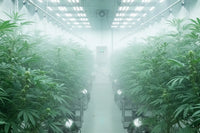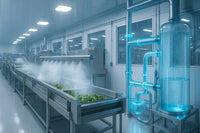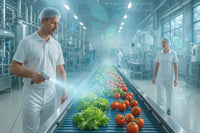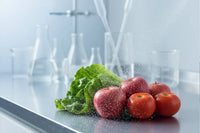Over the past half-decade or more, there has been renewed interest in protecting our environment from human-introduced toxins and pollutants. Water pollution is caused by thousands of chemicals contained in cleaning products. Volatile organic compounds (VOC), sprayed from disinfection product aerosols and sprays, play havoc with our indoor and outdoor air quality. And the empty toxic cleaning product containers end up in landfills and garbage disposals, further exacerbating environmental catastrophe. Switching to a non-toxic disinfecting solution can make the difference!
The Challenge of Protecting Young Children
Risks to our food supplies from toxic cleaning products, the damage to our air quality, and the destruction to our water supplies are important considerations. Other important aspects to consider when deciding on how to clean and disinfect homes and other places where families and groups reside and congregate, are kids. When it comes to protecting young children, there’s a two-dimensional consideration in the choice of which cleaning products you choose. That’s because:
- Firstly, children are typically more vulnerable to viruses, germs, and other impurities and environmental contamination. It’s therefore imperative that you regularly clean and disinfect their surroundings. The challenge, however, is in choosing a cleaning solution that’s efficacious in providing the desired levels of cleanliness
- Secondly, and more importantly, is that youngsters are highly susceptible to the after-effects of disinfection. For instance, their skin is often more sensitive to the ingredients used in a disinfectant. For example, when deciding how often to sanitize baby bottles, parents must also ask the question: What sanitizing products are best to use?
Both dimensions of child-care, with relation to cleansing and sanitization, depend not on just how one goes about implementing disinfection protocols, but also on which products are best suited for the purpose. It’s also important to consider the safety and effectiveness of those products. On the one hand, an ineffective product will still leave young children vulnerable, regardless of how much (or little) of it you use, and how often you use it. On the other hand, using chemically laced cleaning solutions might kill germs and viruses, but they could potentially have health impacts on children.
So what is the most practicable solution? Use non-toxic cleansers, such as Hypochlorous acid, a (HOCL)-based cleaning product, to clean and disinfect the baby’s environment.
Protecting Vulnerable Seniors
New parents often fret over how to disinfect baby bottles in ways that are effective, while also being safe for the baby. However, while those concerns are understandable and valid, an associated concern is the protection of the elderly. Like babies and toddlers, many seniors have compromised immune systems, and there lies the dual challenge:
- Immuno-compromised individuals require everything around them to be clean and germ-free. While airborne illnesses are a common concern for older adults, their weakened immune systems leave them especially vulnerable to viruses and germs that reside on touch-surfaces. So, a rigid disinfection protocol is essential.
- But once again: How do you protect vulnerable adults from the impact of the cleaning products used in the disinfection and cleansing protocols?
There are two sides to the coin when it comes to cleaning for seniors. On one hand, neglecting regular cleaning or reducing its frequency or intensity can have negative consequences. On the other hand, frequent and aggressive cleaning with disinfection products containing toxic chemicals can also harm seniors. The chemicals can make it difficult for them to breathe and the residue left on touch surfaces can lead to other healthcare challenges.
The only way to resolve these issues is by using a non-toxic disinfecting solution, such as Hypochlorous acid (HOCL).
Protecting Pets and Plants
If their environment and living places aren’t properly sanitized and cleaned, animals too are susceptible to the illness-causing abilities of bacteria and germs. Some viruses and germs can be especially defiant, and may even impact the health and wellbeing of domesticated pets, such as birds, cats, dogs and other small animals. In fact, the regular use of safe, non-toxic cleaning products is recommended, for cleaning birdcages, aviaries, kennels and other habitats to protect pets from illness and disease.
The majority of plants share the same air that exists in indoor environments and human living spaces, as they live and breathe in it. As such, the quality of those environments matters for the continued health and wellbeing of plants and vegetation. If, for instance, we lace the environment with harmful chemicals – such as bleach or ammonia contained in chemical cleaning products – it’s likely that our plants will ingest those chemicals too. The result can often be catastrophic for vegetation and plant life.
What Makes Non-toxic Cleaners an Ideal Choice?
As discussed, cleanliness and hygiene aren’t just important for younger populations; they’re also vital for older adults – and everyone in-between. A germ and virus-free environment is also essential for plants and pets. So, why choose non-toxic house cleaning products over some other alternative solutions out there? Well, there are several reasons for doing so:
- They’re environment-friendly: This means that their continued use doesn’t threaten the environment in and around where they are used. Consumers may continue their usual cleaning and disinfecting protocols, such as washing dishes and sanitizing tables and countertops, without worrying about any damage to the environment – both indoors and outside.
- They’re safe for humans: We’ve discussed earlier, that non-toxic disinfectants and cleansing agents are safe to the touch. Even when used without protection, such as gloves and masks, these products pose no risk to humans. Users may, therefore, use them per the recommended application guidelines without exposing themselves to any harmful side effects.
- They’re non-absorbent to the human skin: Many chemical-based cleansing agents cause serious skin reaction. From abrasions to rashes, the chemical ingredients can irritate the skin and cause discomfort to users of these products. With a non-toxic product, there are no such risks.
- Allergy-free cleaning and disinfecting: Using non-toxic products in your cleansing routines avoids any allergic reactions and other conditions that chemical-based solutions trigger. This is an especially important benefit for those in the cleaning profession, such as maids and janitors, who are typically exposed to these products for prolonged periods of time.
- Easy to mass-produce at home: Unlike complex chemical formulations, non-toxic cleansers and disinfectants don’t require complex chemical formulations or costly equipment to produce. Highly effective products, such as Hypochlorous acid can, in fact, be produced at home, using nothing more complex than table salt, regular tap water, and an electrical charge.
- Safe for infants and adults: For parents looking for baby-safe cleaning products, there’s no better option than using a non-toxic disinfectant like HOCL. Not only will you avoid leaving harmful residue on the baby’s bottles, but you can also safely use it to clean and disinfect baby toys, diapers, kitchen utensils, tables and countertops. It is safe to use for babies and adults alike!
- They protect “things” too! A non-toxic disinfectant solution is non-corrosive, and therefore it is “thing-friendly”. On the other end of the spectrum are chemical-based products like bleach, which, over time, can corrode surfaces of metallic objects. Prolonged use of undiluted chemicals can also damage tiles, and eat through plaster-based grouting, caulking, and sealants in kitchens and bathrooms.
The fact that the world is focused on environmental issues, and concerned about how to protect it, is reason enough to switch to environmentally friendly cleaning products. In addition to all the benefits listed here, there’s one priceless benefit from adopting an eco-friendly lifestyle: Once you switch to using these products, it’ll make you feel better about yourself, because you too will be doing your part to protect the environment.
Never Too Late to Make the Switch
In conclusion, the use of non toxic house cleaning products is the best way to protect your home and family, but also your business, staff, customers, and the environment. They’re safe for children and adults alike, as well as highly recommended for use around vulnerable populations, including people who are immune-compromised.
When you switch to an environmentally safe cleaning and disinfecting product, such as HOCL, you also benefit from the ability to produce your own disinfectant – right at home! Today, there are affordable Hypochlorous acid-making machines that home and business owners can buy and use to produce unlimited quantities of the most effective non-toxic disinfecting solution available.
So, why is HOCL considered a natural, non-toxic alternative to chemical-based cleaning solutions? Well, it has to do with the human body! HOCL is produced by our white blood cells as a defense mechanism against bacteria and infection. And how does it work? It does its job by attacking invading pathogens the moment it encounters them, thereby breaking down the outer walls of the cells, penetrating deep inside and destroying the unwelcome invaders.
When you switch to a non-toxic HOCL-based disinfecting and cleaning product, you get the same type of protection to your home and environment, as that which HOCL naturally delivers to your body. The only difference is that now, thanks to commercially-available HOCL-manufacturers, you don’t have to depend on your body’s defense system to produce a germ and virus killer. You have the capacity to manufacture unlimited quantities of baby-safe cleaning products and household disinfectants.
It’s never too late to switch and benefit from all the advantages that eco-friendly cleaning has to offer!
Other Uses of Hypochlorous Acid
We said earlier that hypochlorous acid is a general disinfectant. These are the other things that hypochlorous acid can be used to disinfect:
- Food Produce
- Meat
- Furniture
- Surgical/Medical Equipment
- Livestock
- Water
- Seafood
- Poultry
- Household furniture and fittings
- Toilets and bathrooms, among others.





